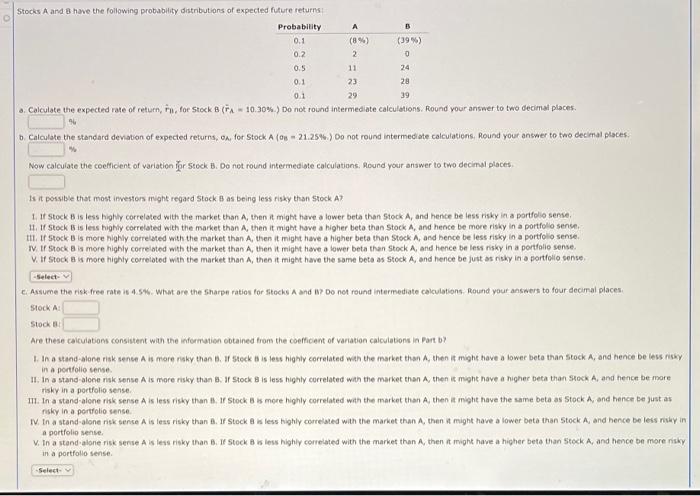Stocks A and 8 have the following probability distributions of expected future returns: a. Calculate the expected rate of return, r1, for stock B ( rA=10.30%.) Do not round intermediate calculations. Round your answer to two decimat places. b. Calculate the standard devation of expected returns, on, for Stock A (og =21.2576 ) Do not round intermediate calculatiens. Round your answer to two decimal places. Now calcuiate the coefficient of variation T Stock B. Do net round intermediate calculations. Round your answer to two decimal places. Is it possible that most investors might regard Stock B as being less risky than Stock. A7. 1. If Stock B is less highly correloted with the market than A, then it might have a lower beta than 5 tock A, and hence be less risky in a portfolio sense. H. If Stock B is less highily cocrelated with the market than A, then it might have a higher beta than S tock A, and hence be more risky in a portfollo sense. III. If Stokk B is more highly correloted with the market than A, then it might have a higher beta than Stock A, and bence be less risky in a portfolo sense. IV. If Stock B is more highly correlated with the market than A, then it might have a lower beta than stock A, and hence be less nisky in a portfalie sense. V. If stock a is more highly correloted with the market than A, then it might have the same beta as stock A, and hence be just as ricky in a portiolio sense. C. Assume the risk. free rate is 4.5\%. What are the sharpe ratios tor sitecks A and B ? Do not round intermediate cakculations. Round your answers to four decimal places. Stock A: Stock E: Are these calculations consistent with the infermation obtained trom the coefficent of variation calculabions in Part b? 1. In a stand-alone risk sense A is mare riaky than B. If steck B is less highly correlated wah the market than A, then is mighe have a lower beta than stock A, and hence be less in a portfolio sense. II. In a stand-alone risk sense A is more risky than B. If Stock B is less highly correlated with the market than A, then is might have a higher beta than Stock A, and hence be mod risky in a portfolio sense. 1iI. In a stand-alone risk sense A is less risky than B. If Stock B is more highly correlated wath the market than A then it might have the saine beta as Stock A, and hence Be just risicy in a portfolio sense. IV. In a stand-alone nsk sense A is less risky than B. If Stock A is less highly correlated with the market than A, then it might have a lower beta than 5 tock A, and hence be leis r a portfolio senie. V. In a stand alone risk sense A is less risky than B. If Stock B is less highly conrelated with the market than A, then it might have a higher bete than Stock A, and hence be mort in a portfollo sense







